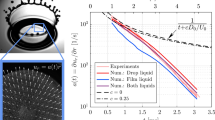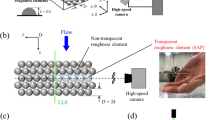Abstract
Pressure-swirl atomizers are often employed to generate a water-mist spray, typically employed in fire suppression. In the present study, an experimental characterization of dispersion (velocity and cone angle) and atomization (drop-size axial evolution) was carried out following a previously developed methodology, with specific reference to the initial region of the spray. Laser-based techniques were used to quantitatively evaluate the considered phenomena: velocity field was reconstructed through a Particle Image Velocimetry analysis; drop-size distribution was measured by a Malvern Spraytec device, highlighting secondary atomization and subsequent coalescence along the spray axis. Moreover, a comprehensive set of relations was validated as predictive of the involved parameters, following an inviscid-fluid approach. The proposed model pertains to early studies on pressure-swirl atomizers and primarily yields to determine both initial velocity and cone angle. The spray thickness is also predicted and a classic correlation for Sauter Mean Diameter is shown to provide good agreement with experimental results. The analysis was carried out at the operative pressure of 80 bar; two injectors were employed featuring different orifice diameters and flow numbers, as a sort of parametric approach to this spray typology.
Similar content being viewed by others
References
Rasbash, D. J., Rogowski, Z.W., “Extinction of fires in liquids by cooling with water sprays”, Combust. Flame, 1 (1957), pp. 453–466.
Rasbash, D. J., Rogowski, Z.W., Stark, G.W.V., “Mechanisms of extinction of liquid fires with water sprays”, Combust. Flame, 4 (1960), pp. 223–234.
Liao, G., Liu, J., Qin, J., Yao, B., “Experimental study on the interaction of fine water spray with liquid pool fires”, J. Therm. Sci., 10 (2001), pp. 377–384.
Adiga, K. C., Hatcher Jr., R.F., Sheinson, R.S., Williams, F.W., Ayers, S., “A computational and experimental study of ultra fine water mist as a total flooding agent”, Fire Saf. J., 42 (2007), pp. 150–160.
Yang, L., Zhao, J., Xu, Z., “Calculation of fire extinguishment time with water mist in an enclosed room”, J. Therm. Sci., 19 (2010), pp. 561–566.
Yang, L., Zhao, J., “Fire extinct experiments with water mist by adding additives”, J. Therm. Sci., 20 (2011), pp. 563–569.
Ni, X., Chow, W.K., “Performance evaluation of water mist with bromofluoropropene in suppressing gasoline pool fires”, Appl. Therm. Eng., 31 (2011), pp. 3864–3870.
Santangelo, P. E., Tartarini, P., “Full-scale experiments of fire suppression in high-hazard storages: A temperature-based analysis of water-mist systems”, Appl. Therm. Eng., 45–46 (2012), pp. 99–107.
Grant, G., Brenton, J., Drysdale, D., “Fire suppression by water sprays”, Prog. Energy Combust. Sci., 26 (2000), pp. 79–130.
Santangelo, P. E., “Characterization of high-pressure water-mist sprays: Experimental analysis of droplet size and dispersion”, Exp. Therm. Fluid Sci., 34 (2010), pp. 1353–1366.
Sheppard, D. T., Lueptow, R.M., “Characterization of fire sprinkler sprays using particle image velocimetry”, Atom. Sprays, 15 (2005), pp. 341–362.
Wang, X. S., Wu, X.P., Liao G.X., Wei, Y.X., Qin, J., “Characterization of a water mist based on digital particle images”, Exp. Fluids, 33 (2002), pp. 587–593.
Paulsen Husted, B., Petersson, P., Lund, I., Holmstedt, G., “Comparison of PIV and PDA droplet velocity measurement techniques on two high-pressure water mist nozzles”, Fire Saf. J., 44 (2009), pp. 1030–1045.
Ren, N., Blum, A., Do, C., Marshall, A.W., “Atomization and dispersion measurements in fire sprinkler sprays”, Atom. Sprays, 19 (2009), pp. 1125–1136.
Orme, M., “Experiments on droplet collisions, coalescence and disruption”, Prog. Energy Combust. Sci., 23 (1997), pp. 65–79.
Santangelo, P. E., Valdiserri, P., Tartarini, P., “Experimental Parametric Analysis of Water-Mist Sprays: An Investigation on Coalescence and Initial Dispersion”, Proc. ASME 2011 International Mechanical Engineering Congress & Exposition (IMECE 2011), Denver, CO, USA, vol. 6, pp. 1167–1174, 2011.
Santangelo, P. E., Tartarini, P., Pulvirenti, B., Valdiserri, P., Marshall, A.W., “Fire Suppression by Water-Mist Sprays: Experimental and Numerical Analysis”, Proc. 14th International Heat Transfer Conference (IHTC-14), Washington, DC, USA, vol. 5, pp. 571–580, 2010.
Adrian, R. J., Westerweel, J., Particle Image Velocimetry, Cambridge University Press, Cambridge, UK, 2010.
Lefebvre, A. H., Atomization and Sprays, Hemisphere, Washington, DC, USA, 1989.
Santolaya, J. L., Aísa, L.A., Calvo, E., García, I., García, J.A., “Analysis by droplet size classes of the liquid flow structure in a pressure swirl hollow cone spray”, Chem. Eng. Process., 49 (2010), pp. 125–131.
Faeth, G. M., Hsiang, L.-P., Wu, P.-K., “Structure and breakup properties of sprays”, Int. J. Multiph. Flow, 21 (1995), pp. 99–127.
Post, S. L., Abraham, J., “Modeling the outcome of drop-drop collisions in Diesel sprays”, Int. J. Multiph. Flow, 28 (2002), pp. 997–1019.
Kim, H. J., Suh, H.K., Park, S.H., Lee, C.S., “An Experimental and Numerical Investigation of Atomization Characteristics of Biodiesel, Dimethyl Ether, and Biodiesel-Ethanol Blended Fuel”, Energy Fuels, 22 (2008), pp. 2091–2098.
Qian, L., Lin, J., Xiong, H., “A Fitting Formula for Predicting Droplet Mean Diameter for Various Liquid in Effervescent Atomization Spray”, J. Therm. Spray Technol., 19 (2010), pp. 586–601.
Cao, J., “On the Theoretical Prediction of Fuel Droplet Size Distribution in Nonreactive Diesel Sprays”, J. Fluids Eng. — Trans. ASME, 124 (2002), pp. 182–185.
Giffen, E., Muraszew, A., Atomization of Liquid Fuels, Chapman & Hall, London, UK, 1953.
Dombrowski, N., Johns, W.R., “The aerodynamic instability and disintegration of viscous liquid sheets”, Chem. Eng. Sci., 18 (1963), pp. 203–214.
Rizk, N. K., Lefebvre, A.H., “Internal Flow Characteristics of Simplex Swirl Atomizers”, J. Propul. Power, 1 (1985), pp. 193–199.
Lefebvre, A. H., “The Prediction of Sauter Mean Diameter for Simplex Pressure-Swirl Atomizers”, Atom. Spray Technol., 3 (1987), pp. 37–51.
Wang, X. F., Lefebvre, A.H., “Mean Drop Sizes from Pressure Swirl Nozzles”, J. Propul. Power, 3 (1987), pp. 11–18.
Author information
Authors and Affiliations
Rights and permissions
About this article
Cite this article
Santangelo, P.E. Experiments and modeling of discharge characteristics in water-mist sprays generated by pressure-swirl atomizers. J. Therm. Sci. 21, 539–548 (2012). https://doi.org/10.1007/s11630-012-0579-5
Received:
Published:
Issue Date:
DOI: https://doi.org/10.1007/s11630-012-0579-5




